On Monday, July 5th, 2004, we were on our first full day of vacation having
made it to my sister (Carol) and brother-in-law's (Rob) house near Charlevoix in northwestern lower
Michigan. We drove to nearby Ellsworth to have breakfast with my sis and bro-in-law. Right
after I ordered the "Farmer's Breakfast", Rob made the big mistake of ordering the "Farmer's Wife".
I managed to get Rob's face to turn a couple shades of red and we all had a good laugh when
I offered up a few jokes to the waitress about my "new wife". After breakfast, we parted ways
with Rob and Carol and headed out to do a little driving in the plush green countryside.
I turned onto a road that we had never been on just to see where it went. Before
long, we happened by a gravel pit, one of many in this part of Michigan. I noticed by the sign
in front of the gravel pit that the owners had a familiar name and that my name was probably familiar
to them as well. So, I decided that it would be alright for us to pull in to see what kind of rocks
the place had to offer. "You never know" - I said to Chrissy and she agreed.
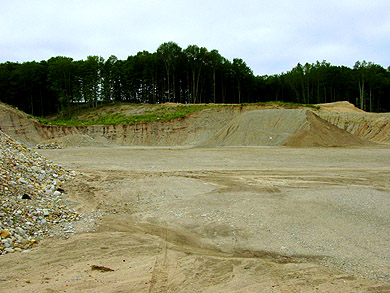
Gravel Pit
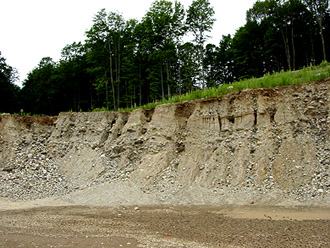
Gravel Pit Wall
I noticed by the stratification on the loose walls that the gravel pit was
located in what appeared to be an ancient shoreline deposit. The Great Lakes have fluctuated
greatly in elevation many times since the last ice age that receded from this area of Michigan
approximately 11,000 years ago. The poorly sorted sand, cobbles and boulders were deposited
along the southern shoreline of what was then Lake Algonquin, that would would later become known as
Lakes Michigan and Huron.
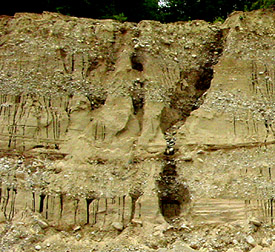
Gravel Pit Wall Close-up
The gravel pit's rocks were no different in character than those
found on many present-day northwestern Michigan beaches, except that these were deposited many thousands
of years earlier. We hoped be able to find some Petoskey stones without having to walk the well-picked
over beaches or by snorkeling in still-frigid Lake Michigan. The quarry walls represented many
different ancient beaches and seasons, all rolled up into one very nice cross section that
had been cut by a trackhoe and erosion.
Opal took advantage of a large pile of sorted rocks to get a good look
at the surrounding countryside from a vantage point high above the pit floor.
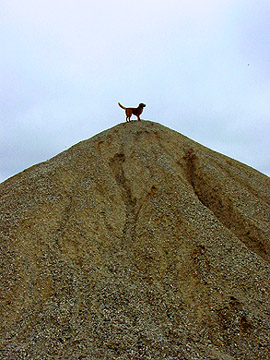
Opal - "Queen of the Hill"
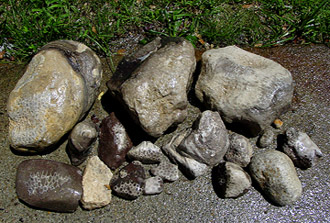
Petoskey Stones
Click picture to enlarge
We would soon find out that this gravel pit did, indeed, contain many Petoskey stones.
A Petoskey stone is a fossil colonial coral that lived in the warm Michigan seas during Devonian time,
around 350 million years ago. The name Hexagonaria (meaning six sides) percarinata
was designated by Dr. Edwin Stumm in 1969. This type of fossil is found only in the rock strata
called the Gravel Point Formation that is part of the Traverse Group only found in northern Michigan.
The glaciers scooped up and deposited chunks of coral that were rounded by wave action.
I found a some large boulders with carbonate veins showing on the outside.
Since veins can sometimes mean pockets, I used my 6-pound sledge to break apart a few likely
candidates. We were delighted to find that there were pockets in the boulders that contained
aragonite, calcite and pyrite crystals, as you can see in the following pictures.
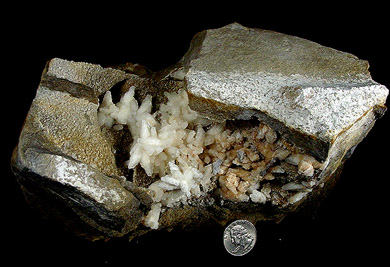
Aragonite on Limestone
Click picture to enlarge
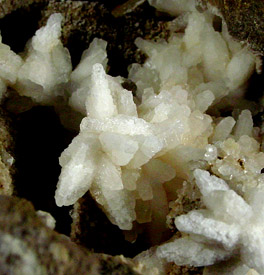
Aragonite on Limestone - Close-up
Click picture to enlarge
We noticed after we got home that the aragonite fluoresced to a bright white under
short-wave ultraviolet light.
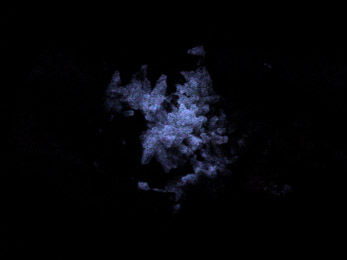
Aragonite under Short-wave UV
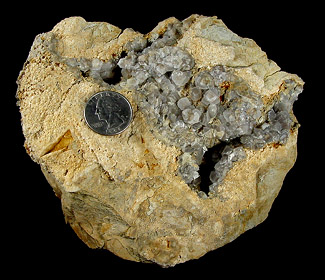
Calcite on Limestone
Click picture to enlarge
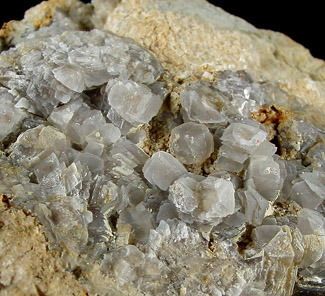
Calcite on Limestone - Close-up
Click picture to enlarge
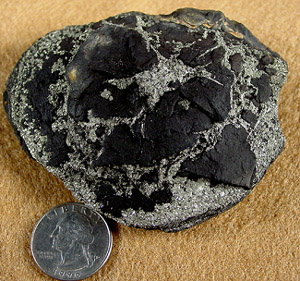
Pyrite in shale
Click picture to enlarge
The expression, "sometimes you never know", has served us pretty well
over the years, as was again illustrated in this northwestern Michigan gravel pit.
KOR
Mike